Mike Mignola wrote the first Hellboy comic in 1994, starting the chain of what would branch off into the large imagined world of Hellboy. With expanding universes, there always comes a point where there is just a huge amount of media to consume. It’s important to remember that there is no right way to start watching or reading Hellboy, or anything else for that matter. Genuinely, since there is just so much, it becomes difficult to find a linear way to absorb everything the Hellboyverse has to offer. However, to remedy this, I am here to recommend some things.

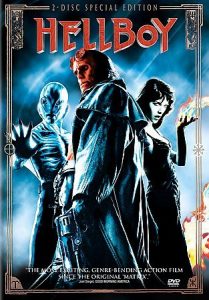
Del Toro’s Hellboy (2004)
In the first live-action Hellboy, arguably the best, director Guillermo Del Toro reimagines Hellboy and his story for a new movie-going audience. This makes the films and comics merge into separate canons. However, the film’s storyline was partly inspired by Mike Mignola’s Seed of Destruction. This movie follows a young Trevor Bruttenholm (often referred to as Broom) and the Allied military crew as they set off to divert the plans of a supernatural Nazi force. After their success and the arrival of the demonic child known as Hellboy, the Bureau for Paranormal Research and Defense (B.P.R.D) is created. Sixty years later, following a grown Hellboy, the evil forces from the past come back to reclaim Hellboy and his intended destiny. Hellboy fights back defiantly, remembering the humanity his father, Broom, taught him.
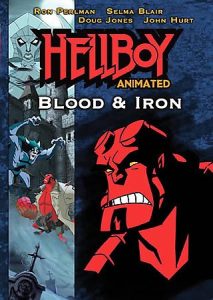
Hellboy: Blood and Iron (2007)
Blood and Iron loosely follows the Hellboy: Wake the Devil comic storyline while adding new visually appealing flairs. In the film, Hellboy, Elizabeth and Abe follow Broom’s past investigation that leads them into a new Long Island mystery. The team discovers Erzebet, a vampire who likes to bathe in the blood of the innocent, and Hellboy tries to fight the murderous creature, all while resisting its devilish temptations. Meanwhile, the B.P.R.D. work together to prevent Erzebet from completing a deadly ritual. Hellboy: Blood and Iron is another reminder of Hellboy’s connection to humanity and is easily a great watch—and is considerably more entertaining than its partner animated film, Sword of Storms. This straight-to-DVD animated film has the same iconic actors from the 2004 film.
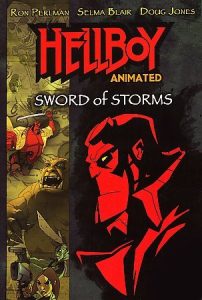
Hellboy: Sword of Storms (2006)
With the wild success of the 2004 Hellboy, Sword of Storms was animated and released on Cartoon Network and DVD. With Perlman, Blair, and Jones returning to voice their characters, Hellboy: Sword of Storms creates new lore, not following anything distinct from Mignola’s comics. Sword of Storms follows the legend of a Japanese katana with two trapped demon souls: Thunder and Lightning. Once Hellboy touches the katana, he is transported into another dimension where he must stop the arrival of the demons and help the other spirits pass on. Hellboy: Sword of Storms aligns well with Hellboy’s personality. It’s a fun animated movie and is worth the watch.
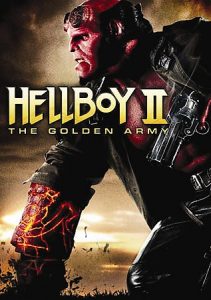
Hellboy II: The Golden Army (2008)
The second live-action Hellboy film technically has a better audience rating than the first, but in my mind, it never lives up to the first movie’s magic. Hellboy II: The Golden Army doesn’t follow Mike Mignola’s Hellboy canon, either. Golden Army follows Hellboy, Liz, Abe and the new B.P.R.D. head as they try to prevent an elven prince from awakening a murderous clockwork army. This army would destroy all of humanity and allow Earth to be ruled by magical creatures. Again, Hellboy’s fight against magical creatures is fueled by his love for humanity and the family he has at the Bureau. We are left in the dark about what Hellboy will choose to do with his new future.

Neil Marshall’s Hellboy (2019)
This is the reboot from Hell, with the worst audience rating of all. Hellboy (2019) was going to be a direct sequel to Hellboy II: The Golden Army, but Ron Perlman refused to reprise his role as Hellboy because director Del Toro wasn’t involved. This forced production to shift the third live-action Hellboy away from the continuity of the first two films. This new film draws inspiration from the comics Darkness Calls, The Wild Hunt, The Storm and the Fury and Hellboy in Mexico. Just like the previous movies, Hellboy (2019) doesn’t stick to Mike Mignola’s canon; however, unlike its predecessors, this film is a poor representation of the Hellboy series. Hellboy (2019) follows Hellboy and his allies as they battle an evil blood queen (a medieval sorceress from the past) who wants to unleash a dark plague upon modern-day England. However, the film suffers without Hellboy’s most iconic teammates.
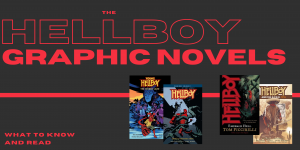
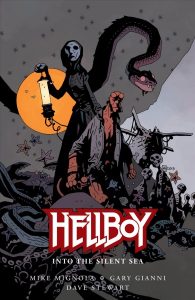
Hellboy: Into the Silent Sea
One of my favorite Hellboy stories, Into the Silent Sea, perfectly captures the essence of Hellboy. Hellboy gives up on his life at B.P.R.D. (again) and begins to wander, floating through life lost and alone, until he is captured by sailors of an eerily old ship. This story showcases a grittier illustration style, a heavy contrast from how Hellboy and his world are typically depicted. Which I believe is a reflection and reminder of Hellboy’s extreme isolation. Hellboy, throughout his many depictions, has always been defined by this isolation and the mystery of who he is. He is an outsider, and that is all he has. Definitely a gory (not graphic), spooky adventure, Into the Silent Sea is a Hellboyverse must-read!
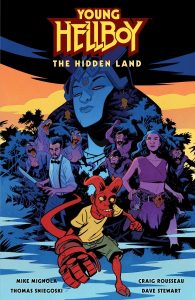
Young Hellboy: The Hidden Land
Young Hellboy is a series of stories about Hellboy’s childhood antics. An easy, colorful read, these stories show, in my belief, how and why Hellboy never becomes the prophesized “ender of worlds.” In this specific volume, Hellboy and Professor Broom travel to their next supernatural mystery, until their plane crashes and they become stranded on a mysterious island. Young Hellboy is full of youthful excitement, finally meeting his comic book ideal, Scarlett Santiago (I’m sure this is a reference to Carmen Sandiego), and finding himself at the center of danger with yet another vampire. If you’re looking for Hellboy-fueled action, this is definitely not the story for you. This version of Hellboy is a child and a mere observer in all the action. Yet this depiction of Hellboy is another reminder of his interestingly strange and ultimately isolating childhood.
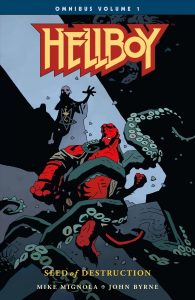
Hellboy Omnibus Volume 1: Seed of Destruction
If you’re not familiar, an omnibus is a collection of several works, normally compiled or curated for a specific theme. Similar to anthologies, they’re not necessarily from the same author. They are also longer than a normal graphic novel, so they offer more in a single collection. And Seed of Destruction is the perfect Hellboy omnibus to start with because it shows us Hellboy’s origins and the iconic moment when Professor Broom and the army squad are photographed with Hellboy.
Seed of Destruction spans Hellboy’s life between 1944 and 1994, including the death of his adoptive father, Professor Broom. Hellboy isn’t given any time to mourn his loss and instead must venture into the newest B.P.R.D. mystery. The stories in this omnibus follow Hellboy, Elizabeth Sherman and Abe Sapien through Hellboy’s prominent life moments, reflecting on his trauma, how he cares for his friends and his pervading identity issues.
Hellboy Omnibus Volume 1 includes: Seed of Destruction, The Wolves of Saint August, Wake the Devil, The Chained Coffin and Almost Colossus.
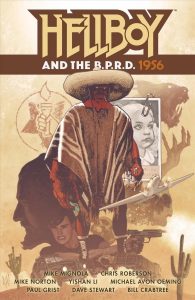
Hellboy and the B.P.R.D. 1956: Issues 1–5
Warning: Hellboy is not the main focus of this story! Hellboy and the B.P.R.D. 1956 is a graphic novel that runs parallel with Hellboy in Mexico (another amazing story). After the loss of Hellboy’s childhood dog, he feels mistreated and decides to hide away in Mexico rather than deal with his current assignment. After Hellboy disappears, B.P.R.D. is forced to deal with the supernatural mysteries surrounding a Soviet Union organization.
Hellboy and the B.P.R.D. 1956 stands out because of the shifting art styles between the American and Russian storylines. Despite the lack of Hellboy’s presence in this story, it’s an important read because it shows us what would happen if Hellboy were gone. And though the members of B.P.R.D. are worried about Hellboy, they must continue the mission of their organization. If you want something with more Hellboy action and an overall sense of resolution, you might just want to also read Hellboy in Mexico.
Access a digital copy of Hellboy and the B.P.R.D. 1956 today
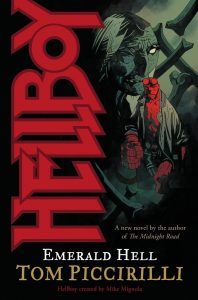
Hellboy: Emerald Hell
This book is not a graphic novel. This particular series is the Hellboy novelization. If you need a break from the classic comic book style, these are actually a pretty fun alternative. Emerald Hell is the seventh title in the series and follows Hellboy to a small town with mysterious occurrences. Eventually, Hellboy must protect a young girl, Sarah Nail, who has chosen to hide from her family. Sarah is being hunted by several people, including her stepfather, Brother Jester: an evil undead preacher. Emerald Hell is not the typical gritty, fists-first action story. Instead, Hellboy relies on his humanity and moral dedication to save the young girl.
Access a digital copy on hoopla or check out a physical copy today
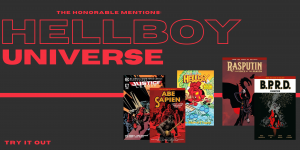
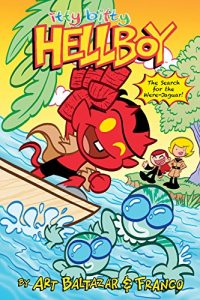
Itty Bitty Hellboy: The Search for the Were-Jaguar!
Honorable Mention Reasoning: It’s cute
This is definitely Hellboy for children. The Itty Bitty Hellboy series follows tiny Hellboy and his friends as they work to solve mysteries, but this is not considered canon in Mike Mignola’s storyline. Instead, Itty Bitty Hellboy reimagines the team on their super important B.P.R.D. mission (delivering underwear) as it is interrupted by a mysterious beast. Even with foes like Evil Karl and Rasputin trying to stop them, Itty Bitty Hellboy lacks the violence and villainy that you might expect from a Hellboy retelling, so it’s safer for a younger audience. Itty Bitty Hellboy is a quick, fun read for adults and an easy introduction for children.
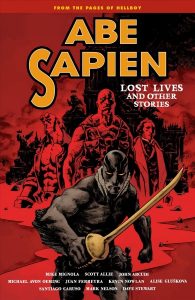
Abe Sapien Volume 9: Lost Lives and Other Stories
Honorable Mention Reasoning: Character relevance
A collection of stories about Abe Sapien, with varying unique art styles per story, this volume harbors the knowledge of who Abe Sapien is and what he chooses to do with that knowledge. Abe, a lot like Hellboy, goes off on B.P.R.D. missions alone, respectfully accepting it as part of his life. Usually diving deep (literally) for each mission, once Abe discovers his long-forgotten origins, his identity and place at B.P.R.D. begins to shift. Regardless of the fact that Abe has always been affected by the mystery of his origins in a vastly different way, Abe Sapien’s stories are worth a read because, in my belief, he is a reflection of Hellboy. Stories included: The land of the dead, Witchcraft and Demonology, The Ogopogo, Subconscious, Lost Lives and Icthyo Sapien.
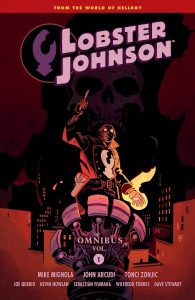
Lobster Johnson
Honorable Mention Reasoning: Character Relevance
Another omnibus, this collection focuses solely on the Lobster. The Lobster is a vigilante in 30s New York, delivering justice to gangsters and any other paranormal threats that disrupt life in the city. Though Hellboy and the Lobster never meet, Hellboy considers the Lobster to be his idol and inspiration. Hellboy in Mexico sets Hellboy in a starring film role opposite to the hero luchador, Lobster Johnson (the Lobster’s name is changed to Lobster Johnson for the film). Which happens to be the closest Hellboy ever gets to the Lobster within the comics. Though, the Lobster does find his way on screen with the 2019 Hellboy in a mid-credit scene. A collection filled with new villains and new adventures, Lobster Johnson is a fun addition to the Hellboy Universe, even if the connection is so minuscule. Stories included: The Empty Chair, The Burning Hand (chapters 1-5), Caput Mortuum, Satan Smells a Rat, Tony Masso’s Finest Hour, A Scent of Lotus, The Prayer of Neferu and Get the Lobster (chapters 1-5).
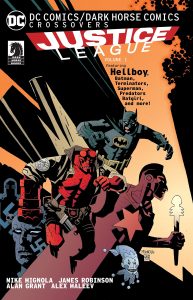
DC Comics/Dark Horse Comics Crossovers: Justice League
Honorable Mention Reasoning: We love a crossover!
Doesn’t have a lot of Hellboy! A collection of four stories with DC and Dark Horse characters, the third story brings Batman, Hellboy and Starman together. Batman and Hellboy team up to save Starman and fight their common Nazi foe, a villain that Hellboy, obviously, has a lot of experience with. Mignola’s art style is exceptional, as usual, and well drawn, showcasing Batman and Starman in a new way. The shortest story within the collection, Hellboy’s crossover into the DC universe, is more of a fun read, than something actually canon to the universe.
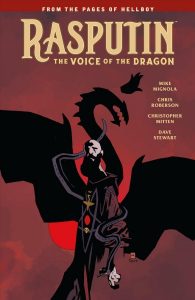
Rasputin: The Voice of the Dragon
Honorable Mention Reasoning: Character relevance
There is no Hellboy in this! Rasputin is often described as Hellboy’s second father, the man who brought him into existence on Earth. A story set to contrast Hellboy’s fathers, Rasputin: The Voice of the Dragon follows Rasputin’s and Professor Broom’s merging stories before the eventual arrival of Hellboy. Set between 1937-1941, the mystic Russian, Rasputin, becomes an influential leader within the Nazi forces, known to them as the Master. The young Professor Trevor Bruttenholm (Professor Broom) decodes a series of mysterious messages and begins to search for answers in occupied Paris. Eventually recruited by a new intelligence agency, Professor Broom discovers that uncovering and stopping the Master’s plans is his top priority. Rasputin: The Voice of the Dragon is the story before Hellboy’s origin, and it easily expands the Hellboy universe.
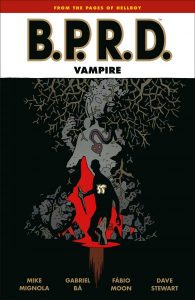
B.P.R.D. Vampire
Honorable Mention Reasoning: You’d be surprised how many vampires Hellboy and B.P.R.D. deal with
Not a story about Hellboy! B.P.R.D. Vampire showcases the B.P.R.D. agent Simon as he searches for the long-hunted vampire clan. Giving glimpses of a very young Hellboy, B.P.R.D. Vampire makes references to some of the plot of Hellboy and B.P.R.D.: 1956. While Simon’s story is short and ends mysteriously, as nothing is resolved, the expectation and the anticipation for more B.P.R.D. missions are all that one can really take from the ending.
